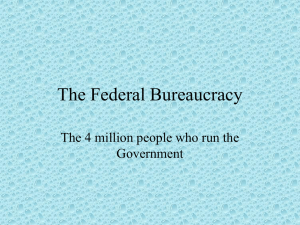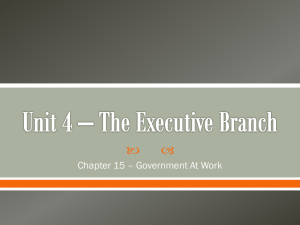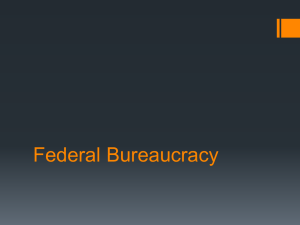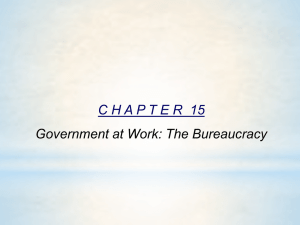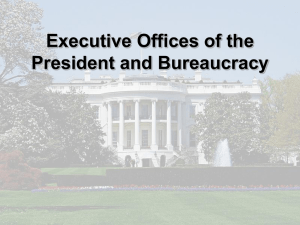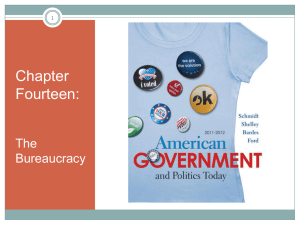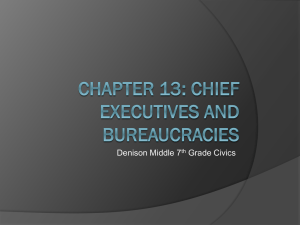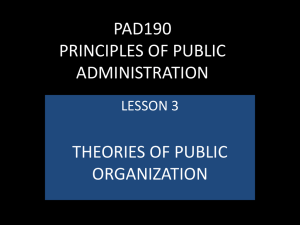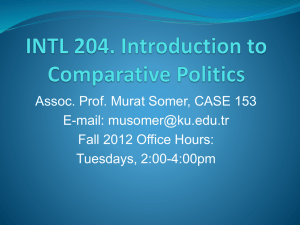Section 2
advertisement
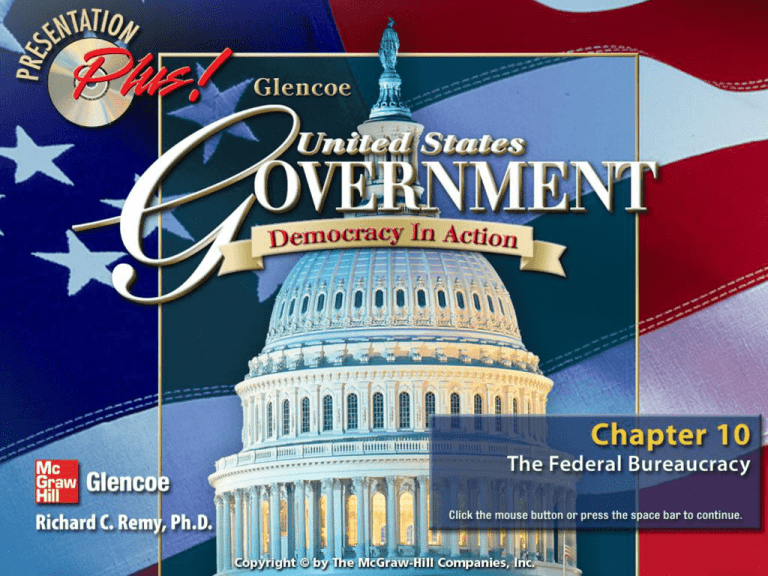
Chapter 10: The Federal Bureaucracy Chapter Focus Section 1 Bureaucratic Organization Section 2 The Civil Service System Section 3 The Bureaucracy at Work Chapter Assessment Chapter Objectives • Bureaucratic Organization Describe the functions of the cabinet, independent government agencies, and regulatory commissions. • The Civil Service System Evaluate the effectiveness of the civil service system. • The Bureaucracy at Work Summarize the advantages and disadvantages of the federal bureaucracy. Bureaucratic Organization Key Terms bureaucrat, embassy, government corporation, deregulate, procurement Find Out • What is the general organizational structure of the 15 cabinet level departments? • How are independent government agencies different from regulatory commissions? Bureaucratic Organization Understanding Concepts Public Policy How does government bureaucracy serve the executive branch in carrying out the will of the people’s representatives? Section Objective Describe the functions of the cabinet, independent government agencies, and regulatory commissions. The first female Secretary of State, Madeleine Albright, speaks English, French, Czech, Russian, and Polish. Her language skills helped her perform well in her previous job as the United States representative to the United Nations, where many different languages are involved in conducting international affairs. I. The Cabinet Departments (pages 276–279) A. The Founders anticipated the need for federal agencies to carry on the daily business of government; currently nearly 3 million civilians work in the federal government. B. These departments are headed by secretaries and staffed with assistant secretaries, deputy secretaries, and directors of major unitsC. C. These 15 executive departments, headed by cabinet-rank officers, are a major part of the federal bureaucracy. I. The Cabinet Departments (pages 276–279) I. The Cabinet Departments (pages 276–279) D. Two of the four departments created by Congress in 1789 are still among the most important: the Departments of State and of the Treasury. E. The other 13 departments are the Departments of the Interior, Agriculture, Justice, Commerce, Labor, Defense, Health and Human Services, Homeland Security, Housing and Urban Development, Transportation, Energy, Education, and Veterans Affairs. I. The Cabinet Departments (pages 276–279) I. The Cabinet Departments (pages 276–279) Which cabinet office performs the most essential service? Explain. Answers will vary. Students should describe the service they believe is most essential. II. Independent Agencies (pages 279–280) A. The federal bureaucracy includes over 100 independent organizations whose heads are appointed by the president. B. The services of several independent agencies, such as the National Aeronautics and Space Administration, are widely publicized and are as large and well known as cabinet departments. II. Independent Agencies (pages 279–280) C. Some agencies such as the Central Intelligence Agency and the General Services Administration provide services directly for the executive branch. D. Government corporations are independent agencies that directly serve the public, such as the Federal Deposit Insurance Corporation and the United States Postal Service. II. Independent Agencies (pages 279–280) How do government corporations differ from private corporations? Government corporations may be given monopolistic powers by Congress, and they are funded by public money. III. Regulatory Commissions: (pages 281–283) A. are independent of all three branches of government; B. make rules for businesses and industries that affect the public interest; C. are often under intense pressures from the groups they regulate and their lobbyists; D. have become more limited in their powers because critics have complained that they overregulate the economy; E. were the subject of regulatory reform by the Republican Congress in the mid-1990s. III. Regulatory Commissions: (pages 281–283) III. Regulatory Commissions: (pages 281–283) Do you support or oppose the federal government’s move toward deregulation of industries and businesses? Explain. Answers will vary. Students should provide logical reasons for their opinions. Checking for Understanding 1. Main Idea Using a Venn diagram like the one below, analyze how regulatory commissions and independent agencies are alike and how they are different. Regulatory commissions: make rules for businesses; do not report to the president. Independent commissions: serve the government or the public. Both: part of the bureaucracy. Checking for Understanding Match the term with the correct definition. ___ B bureaucrat ___ A embassy ___ E government corporation ___ C deregulate ___ D procurement A. an ambassador’s official residence and offices in a foreign country B. one who works for a department or agency of the federal government C. to reduce regulations D. the purchasing of materials E. a business that the federal government runs Checking for Understanding 3. Identify Department of State, Department of the Treasury. The Department of State is responsible for the overall foreign policy of the United States. The Department of the Treasury is responsible for managing monetary resources of the United States. Checking for Understanding 4. How are cabinet departments organized? A secretary heads each department. The second in command is the deputy or undersecretary, then assistant secretaries. Under these top officials are the directors of the departments’ major units and their assistants. Critical Thinking 5. Making Inferences Why is it important that regulatory commissions be free from political pressures? It is important that the regulatory commissions be free from political pressures so that they can be impartial about policies, subject to fewer influences, and regulate what they were created to control. Public Policy Imagine that you are on a presidential commission looking into the establishment of a new executive department. Decide on an important issue facing the country today. Think of a new executive department to deal with this issue. Present your suggestion, with reasons, as an oral presentation to the commission. The Civil Service System Key Terms spoils system, civil service system Find Out • How did the civil service system attempt to reform the spoils system? • What is the difference between a civil servant and a political appointee? The Civil Service System Understanding Concepts Civic Participation How does the civil service system provide access to government jobs? Section Objective Evaluate the effectiveness of the civil service system. During the New Deal, the total federal government bureaucracy was smaller than the number of people hired by just one government agency. From 1935 to 1941, an average of 2.1 million citizens who needed jobs were employed by the Works Progress Administration on various federal projects. Not until 1978 did the federal government bureaucracy grow to 2.1 million employees. I. Civil Service System (pages 284–285) A. Only 11 percent of all federal government employees work in Washington, D.C. B. Many federal employees work in offices throughout the United States and the world. I. Civil Service System (pages 284–285) Compare the composition of the federal workforce today with the workforce in the private sector. About 30 percent of federal workers represent minorities versus 22 percent of the private sector workforce. II. Origins (pages 285–286) A. Government jobs became a spoils system under President Andrew Jackson. B. The spoils system led to inefficiency and corruption in government. C. Calls for reform started in the 1850s. D. The assassination of President Garfield by a disappointed office seeker led to the Pendleton Act of 1883, establishing the present civil service system based on competitive examinations and merit. http://www.youtube.com/watch?v=N6USyilfk6w http://www.youtube.com/watch?v=j6-x_lIhUq8&feature=fvsr E. Assassinated Presidents 1 Successful assassinations 1.1 Abraham Lincoln 1.2 James A. Garfield 1.3 William McKinley 1.4 John F. Kennedy 2 Failed assassination attempts 2.1 Andrew Jackson 2.2 Abraham Lincoln 2.3 Theodore Roosevelt 2.4 Herbert Hoover 2.5 Franklin D. Roosevelt 2.6 Harry S. Truman 2.7 John F. Kennedy 2.8 Richard Nixon 2.9 Gerald Ford 2.10 Jimmy Carter 2.11 Ronald Reagan 2.12 George H. W. Bush 2.13 Bill Clinton 2.14 George W. Bush 2.15 Barack Obama 3 Presidential deaths rumored to be assassinations 3.1 Zachary Taylor 3.2 Warren G. Harding II. Origins (pages 285–286) Do you think the spoils system plays a greater or lesser role in government today than it did during Andrew Jackson’s presidency? Explain. As a percentage of workers: lesser, although presidents appoint about 2,000 officials today. III. The Civil Service System Today (pages 286–288) A. Applicants for federal jobs are evaluated on the basis of their experience and training. B. Government jobs are attractive because they offer many benefits. C. Government workers, unlike most private sector workers, have job security and are difficult to fire. D. The Hatch Act of 1939 was intended to prevent political parties from using federal workers to aid in election campaigns; in recent years, critics have argued for and against this law, with workers now permitted some involvement in politics. III. The Civil Service System Today (pages 286–288) III. The Civil Service System Today (pages 286–288) With which parts of the 1939 Hatch Act do you agree or disagree? Explain. Answers will vary. See text pages 287–288 for discussion of the Hatch Act. IV. Political Appointees in Government (pages 288–289) A. Nearly 10 percent of executive branch employees are appointed by the president, including many choice jobs; this allows the president to place loyal supporters in key offices. B. These political appointees are outside civil service and are first and foremost the president’s political supporters. IV. Political Appointees in Government (pages 288–289) C. Political appointees are not experts in the work of their agencies, and when the president leaves office many of them return to private sector jobs. D. Many political appointees hold their positions for short tenures, making it hard for them to learn about their jobs. As a result, much of the real power over daily operations remains in the hands of career officials. IV. Political Appointees in Government (pages 288–289) Should something be done to avoid the problem of short tenures for political appointees? Why or why not? Answers will vary. See text page 289 for discussion of short tenures. Checking for Understanding 1. Main Idea Using a graphic organizer like the one below, note the advantages and disadvantages of the spoils system and the civil service system. Spoils: advantages—allows victorious politicians to reward their followers; disadvantages—inefficiency, corruption, government workers without needed expertise. Civil service: advantages—competitive salaries, paid vacations, health insurance, early retirement, job security; disadvantages—difficult to terminate incompetent and inefficient workers. Checking for Understanding 2. Define spoils system, civil service system. The spoils system is the practice of victorious politicians rewarding their followers with government jobs. The civil service system is the practice of government employment based on competitive exams and merit. Checking for Understanding 3. Identify Andrew Jackson, Pendleton Act, Hatch Act. Andrew Jackson became president in 1829 and immediately fired about 1,000 workers, replacing them with his own political supporters. His method of appointing federal workers became known as the spoils system. The Pendleton Act, passed by Congress in 1883, created the present civil service system. The Hatch Act limits how involved federal government employees can become in elections. Checking for Understanding 4. What two agencies now make up the former Civil Service Commission? The Office of Personnel Management and the Merit System Protection Board now make up the former Civil Service Commission. Critical Thinking 5. Synthesizing Information Why do you think political supporters are so eager to fill the plum jobs? They seek the challenge of such jobs, may wish to be close to the center of power, make key political decisions, and meet influential people. Civic Participation Imagine that you want to obtain employment in a civil service position. You need to evaluate the negative and positive aspects of such employment. Make a list of the pros and cons of a career in the civil service. Discuss your list with your classmates. The Bureaucracy at Work Key Terms client group, liaison officer, injunction, iron triangle Find Out • What are the advantages and disadvantages of bureaucrats taking a greater role in policy making? • Why do you think people sometimes get frustrated with government bureaucracy? The Bureaucracy at Work Understanding Concepts Separation of Powers What role does the government bureaucracy play in setting policy? Section Objective Summarize the advantages and disadvantages of the federal bureaucracy. The General Services Administration has always furnished office space, products, and services to other federal agencies. The new, cutting-edge GSA has developed a service mentality, despite its stodgy reputation. For instance, it passes on great deals, such as four cents a minute for long-distance calls, and offers a Web-based shopping resource with half a million products. I. Influencing Policy (pages 291–293) A. Policy consists of all the actions and decisions taken or not taken by the government. B. Federal bureaucrats carry out policy decisions made by the president and Congress. C. The bureaucracy often determines what the law means through the rules and regulations it issues. D. In 1995 Congress set paperwork reduction goals for future years. I. Influencing Policy (pages 291–293) E. Bureaucrats aid in shaping policy by helping Congress draft its new laws or by providing ideas for legislation. F. Workers in federal agencies shape policy by their decisions about the application of rules and regulations and by hearing disputes. G. Bureaucrats also supply advice and information to top decision makers, influencing whether an agency supports or opposes certain policies. I. Influencing Policy (pages 291–293) What are the advantages and disadvantages of having federal bureaucrats influence policy decisions? Advantages: efficiency and expertise; Disadvantages: loss of representation by the people. II. Why the Bureaucracy Makes Policy (pages 293–295) A. The growth of the bureaucracy mirrors the growth of the nation’s population and rapid changes in technology. B. The Cold War and international crises since World War II spurred the growth of the bureaucracy. C. The New Deal doubled the size of the federal government. D. Citizen special-interest groups demanded various services and programs. E. Once created, government agencies almost never die. II. Why the Bureaucracy Makes Policy (pages 293–295) Will the federal bureaucracy grow or shrink in the future? Explain. Answers will vary. Downsizing government is popular, but needs for government grow. III. Influencing Bureaucratic Decisions (pages 295–297) A. Congress has an important influence over bureaucrats. B. Congress can influence decision making in federal agencies. C. Congress’s main power over the bureaucracy is its control of agencies’ budgets. D. Citizens may challenge agencies’ actions in courts. III. Influencing Bureaucratic Decisions (pages 295–297) What are ways Congress influences decisions made by the federal bureaucracy? Passing new legislation and controlling agency budgets; Congress also holds agencies accountable for their activities with the Government Performance and Results Act. IV. The Influence of Client Groups (pages 297–298) A. Federal agencies have client groups that try to influence decisions. B. The close cooperation between congressional committees, client groups, and a federal agency or department is referred to as an iron triangle. IV. The Influence of Client Groups (pages 297–298) IV. The Influence of Client Groups (pages 297–298) Critics often complain that iron triangles in the federal government shut out the public and serve only the interests of special groups. Explain. Committees, agencies, and interest groups may work together, ignoring the public interest. Checking for Understanding 1. Main Idea Using a graphic organizer like the one below, identify two ways Congress influences federal agencies and two ways federal agencies contribute to legislation. Answers might include: Congress: new legislation, the budget; Federal agencies: draft bills, testify about legislation. Checking for Understanding Match the term with the correct definition. ___ C client group ___ A liaison officer ___ B injunction ___ D iron triangle A. a cabinet department employee who helps promote good relations with Congress B. an order that will stop a particular action or enforce a rule or regulation C. individuals and groups who work with a government agency and are most affected by its decisions D. a relationship formed among government agencies, congressional committees, and client groups who work together Checking for Understanding 3. Identify Social Security Act, Department of Veterans Affairs. The Social Security Act was passed in 1935 by Congress and established the Social Security system which makes it possible for disabled workers to receive payments from the government. The Department of Veterans Affairs provides important services, such as hospital care, to veterans. Relevant Videos: http://www.youtube.com/watch?v=-gzYlSPpks4 – President Garfield (10min) http://www.youtube.com/watch?v=3n2ceZH4bZ0 - CIA Checking for Understanding 4. What are five reasons that the federal bureaucracy has assumed an important role in making public policy? The five reasons are national growth and technology, international crises, economic problems at home, citizens’ demands, and the nature of bureaucracy. Critical Thinking 5. Making Inferences Do you think that iron triangles undermine or serve the public interest? Explain your answer. Students should support their opinions. Students may note the cooperation of the groups or the undue influence of interest groups. Separation of Powers The government bureaucracy, in theory, carries out the policy decisions of Congress and the president. In practice, however, the bureaucracy also helps influence policy. Create a political cartoon depicting one of the ways in which the federal bureaucracy influences policy.

